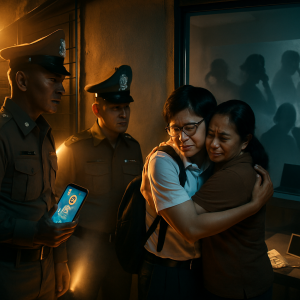In a heart-wrenching and tragic incident that gripped the early morning hours of April 2, a fateful collision on the bustling road leading to Phuket International Airport claimed two lives. The unsuspecting victims were traveling on a motorbike with a sidecar, their journey abruptly cut short as they collided with a commercial passenger van. The scene of despair unfolded at approximately 9:30 a.m. on the busy Route 4026, a critical artery connecting Thepkrasattri Road with the airport, turning what was likely an ordinary day into a somber tale.
The van, a silver Toyota, stood idle in the right-hand lane of the road, its driver, 45-year-old Somporn Sri Sawang, present at the location, assisting the local authorities with their ongoing investigation. Meanwhile, the motorbike, a bright blue Honda Dream outfitted with a sidecar, carried its passengers: 60-year-old Narong Tiangnoi, the rider, accompanied by 68-year-old Ma-ae Udomlak. They were bound eastward toward Thepkrasattri Road when calamity struck.
The impact of the mishap was catastrophic, as emergency responders swiftly arrived, transporting the injured parties to Thalang Hospital. Tragically, despite their efforts, both Narong and Ma-ae were unable to overcome their severe injuries and were pronounced deceased shortly after arrival.
As law enforcement officials from Thalang Police methodically piece together the myriad details surrounding this harrowing event, both witnesses and investigators have been called upon to unravel the sequence of events that led to this tragedy. The van’s driver, Somporn, has been subjected to rigorous drug and alcohol testing, with findings affirming sobriety at the time of the crash. Yet, the inquiry doesn’t rest here; officials are meticulous in their collection of supplementary evidence, as they engage with witnesses to gain a comprehensive understanding of the incident’s causes.
In the midst of these somber events, authorities make a fervent plea to drivers, urging them to exercise heightened caution, particularly in the vicinity of high-traffic zones like Phuket International Airport. Such vigilance, they argue, is vital not only to prevent such tragedies but also to ensure overall road safety, a sentiment echoed by The Phuket News in their recent coverage.
In a disconcerting parallel, just a few hours later in the early hours of April 1, another tragic accident made the headlines. A Russian individual met with his untimely demise after his motorcycle collided with an electricity pole in Phuket. The mortifying crash happened at the stroke of 12:45 a.m. along the Chaloem Phrakiat Rama 9 Road, more commonly known to the locals as Bypass Road, nestled in the Ratsada subdistrict.
Responding to the distress call, officers from the Mueang Phuket Police Station arrived at the crash site, where they encountered a scene of chaos and sorrow. The red and black Honda Forza motorbike lay on the ground, heavily damaged with its parts strewn about. Mere meters away, the lifeless body of the rider was found, separated into two—an appalling testament to the crash’s violent nature.
Such disturbing occurrences remind us of the frailty of life and the necessity for due diligence on the roads. As investigators continue to unravel the threads of these grim events, we are reminded of the relentless progression of life, and the stories that unfold quietly in its wake, urging us to tread carefully as we forge forward through each new day.


















This is heartbreaking. Just another reminder of how dangerous roads can be near airports. What a tragedy for these families.
Absolutely, Tommy. It’s terrible, but I wonder if there might have been more to the crash than just a simple collision.
That’s a possibility, Sara. Hopefully, the investigation will shed some light on it. We need more road safety measures.
Blaming the roads is typical. People must learn to drive more carefully and responsibly. It’s not always the infrastructure.
Why are motorbikes still so popular in Thailand? They seem really dangerous, especially with sidecars.
Motorbikes are economical and efficient for getting around traffic. Risks are high, but they’re central to Thai transport culture.
Maybe it’s time to push for better public transport to reduce reliance on risky bikes.
I think people are missing the point. We need stricter laws and harsher penalties for reckless driving.
This tragedy underscores the need for improved infrastructure, not just harsher penalties. Wider lanes and better lighting would help.
Both are necessary. Improved infrastructure and harsher penalties go hand in hand. One without the other is pointless.
Exactly, Riley. Authorities need to balance law enforcement with better safety designs.
I was there an hour after it happened. It’s surreal to think how life can change in an instant.
The fact that there was another accident in Phuket just a few hours later shows systemic problems with road safety there.
Every year, these grim accidents pile up, yet what changes? Wake-up call for authorities to rethink road safety strategies.
We really need to address driver fatigue. It’s another key factor in these incidences.
Good point, Lee. I read that fatigue plays a role in up to 20% of road accidents.
It’s disheartening that tragic stories like these tend to shift public perception more than actual policy changes.
How many more need to die before something gets done to fix road conditions around Phuket?
Sad to say, Alex, but it seems tragedies are the only thing that prompts meaningful change.
It’s a shame when human life needs to be quantified in deaths for policies to shift.
With all due respect, Phuket needs to seriously look at diversifying transport options, reducing reliance on bikes.
Important to remember that motorists should also respect bikers. It’s a shared road for a reason.
Why was a sidecar even on such a busy road? Aren’t there regulations against that on highways?
I think sidecars are allowed in Thailand in most areas, but maybe they should reconsider busy streets.
The government should fund public safety campaigns focusing on both drivers and motorcyclists.